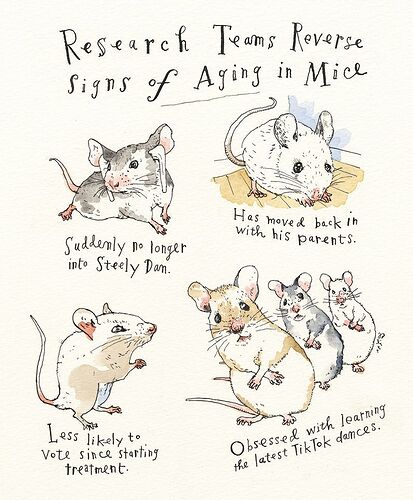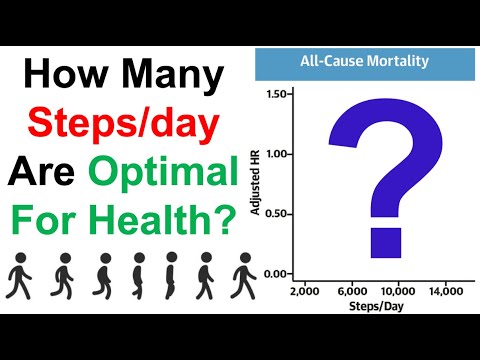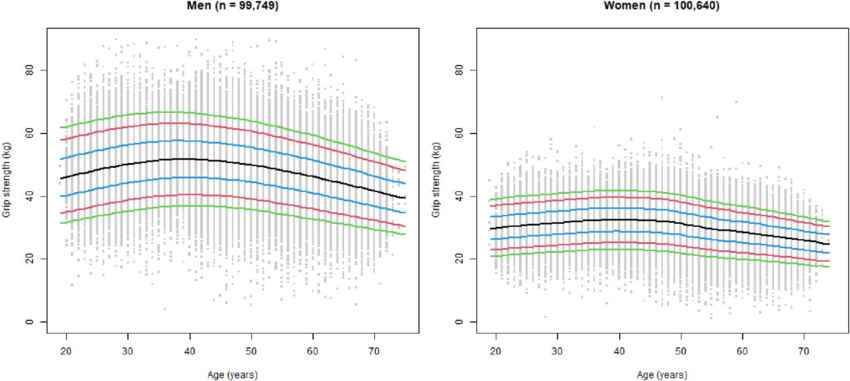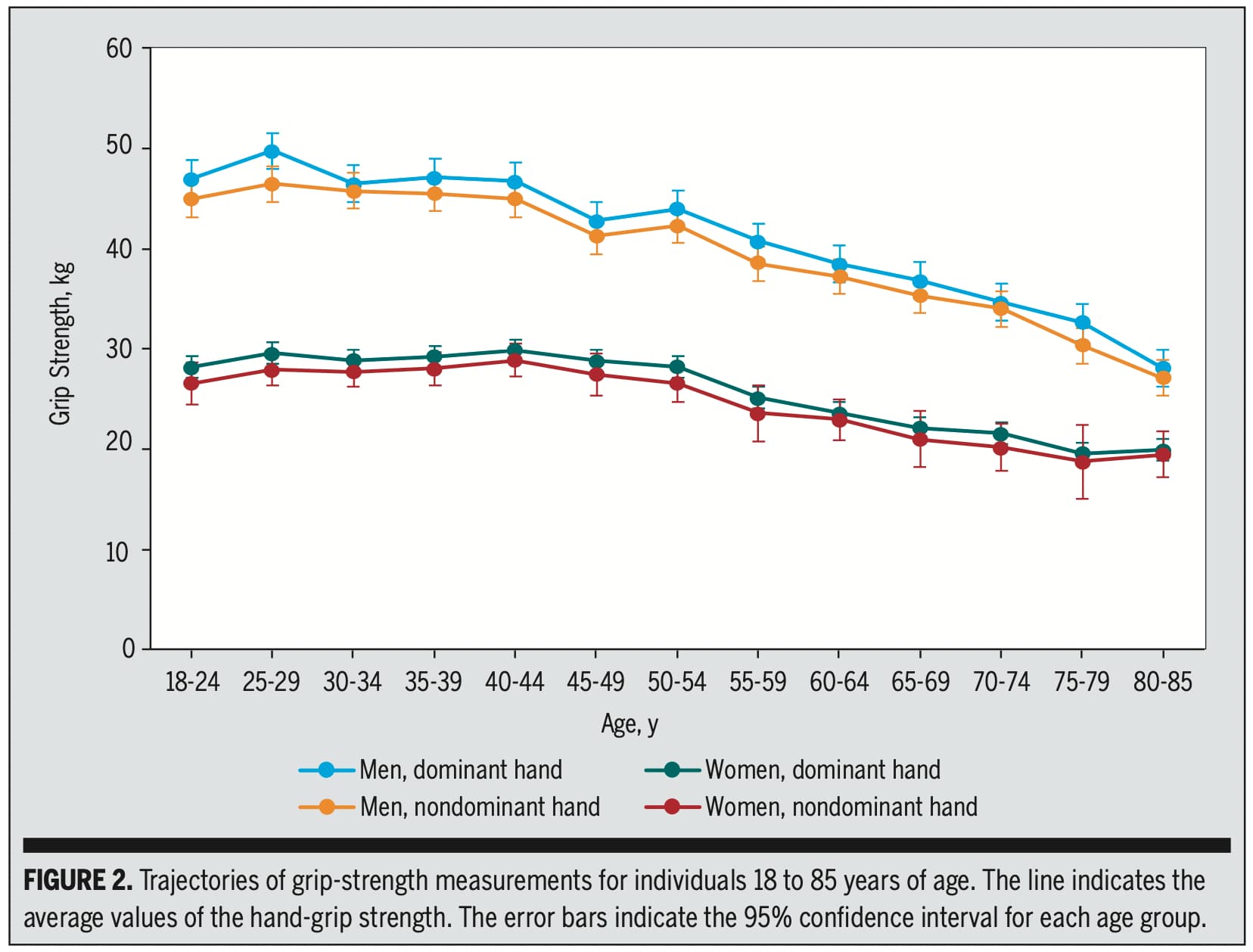Yes, I used the word “marker” but “a surrogate measure of frailty” is a much more elegant way of putting it. My point is that if that’s true, using a grip strengthening device to improve grip strength but not improving whole body strength does nothing except possibility help slightly with blood pressure.
I agree improving grip strength alone would not necessarily improve health, but it might help prevent some falls.
A new paper on this topic (open access paper):
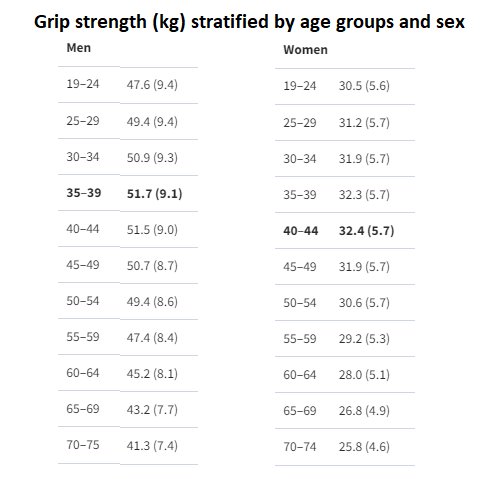
Grip strength values and cut-off points based on over 200,000 adults of the German National Cohort - a comparison to the EWGSOP2 cut-off points
Background
The European Working Group on Sarcopenia in Older People (EWGSOP) updated in 2018 the cut-off points for low grip strength to assess sarcopenia based on pooled data from 12 British studies.
Results
Grip strength increased in the third and fourth decade of life and declined afterwards. Calculated cut-off points for low grip strength were 29 kg for men and 18 kg for women. In KORA-Age, the age-standardised prevalence of low grip strength was 1.5× higher for NAKO-derived (17.7%) compared to EWGSOP2 (11.7%) cut-off points. NAKO-derived cut-off points yielded a higher sensitivity and lower specificity for all-cause mortality.
Conclusions
Cut-off points for low grip strength from German population-based data were 2 kg higher than the EWGSOP2 cut-off points. Higher cut-off points increase the sensitivity, thereby suggesting an intervention for more patients at risk, while other individuals might receive additional diagnostics/treatment without the urgent need. Research on the effectiveness of intervention in patients with low grip strength defined by different cut-off points is needed.
I need to formally test my grip strength, but this is all the confirmation bias I need to keep powerlifting ![]()
It’s only recently that studies are coming out on the longevity & healthspan benefits of heavy strength training. Hormone balance, grip strength, sleep quality, and bone density seem to be the greatest benefits.
Recent pod on this: #239 ‒ The science of strength, muscle, and training for longevity | Andy Galpin, Ph.D. (PART I) - Peter Attia
Seems like grip strength is a nice test of upper body strength. What is the equivalent for the lower body?
The “lower body equivalent of the grip test”? — Stair climbing. One flight of stairs.
I agree on the heavy weight training. I have never been a “gym rat” (old term) but have always been in backpacking shape. Heavy lifting has definitely added lean muscle mass and there are other physiological changes I see/feel (thicker veins, positive hormonal changes, etc.) for which others are taking supplements to get. I’m not happy about @desertshores suggestion I could compress my spine doing deadlifts with heavy weights, but I try to be careful of my form and how I feel, hanging from a bar and doing pull/chin ups to decrease spinal pressure, and taking time to recover. For deadlifts specifically I can say I’ve fairly quickly built abdomen muscle around my entire midsection which seems to solidly stabilize me better than before it was there. So assuming I’m not damaging my spine (and I have regular scans for an unrelated reason which captures this area), I’d say they are a positive. But not if they damage your spine.
I use the “hang test” (hand from a bar with both hands) for as long as I can after every resistance workout. I wouldn’t say I’ve seen any improvement from rapa.
I just bought a similar one on Amazon. What has been your experience with using yours?
I just check every 6 months or so - my grip strength seems pretty good, around 55 to 60kg, so its more something I just will track over time, not a significant concern of mine.
Are you training grip strength or just using grip strength as an early warning signal (canary in the coal mine)?
I am training grip for functional reasons but I suspect that means I lose the longevity signal.
Not a test, but a physical intervention.
Optimal number of steps to walk is 8,763, based on a study reviewed by Michael Lustgarten.
Link to the actual study is below. Full text requires a purchase.
https://www.sciencedirect.com/science/article/abs/pii/S0735109723064008?via%3Dihub
Conclusions
As few as about 2,600 and about 2,800 steps/d yield significant mortality and CVD benefits, with progressive risk reductions up to about 8,800 [mortality] and about 7,200 steps/d [CVD], respectively. Additional mortality benefits were found at a moderate to high vs a low step cadence. These findings can extend contemporary physical activity prescriptions given the easy-to-understand concept of step count.
I think this is one where walking more steps probably has quite a similar benefit although there gets to be a point at which you are walking too much. (as with all exercise there is a limit to benefit).
Its a good video from @ConquerAging aging however.
I don’t specifically train grip strength, but I think it probably gets trained from other activities I do (rock climbing, bar hang, etc.), I’m more just tracking it to make sure its not trending downwards.
Quite so. I’m 47, and I don’t train arms or grip directly, and I’m just barely an intermediate lifter for my age. My doctor tested my right hand grip strength at >70kg and left in the mid 60s (upper 90s in terms of percentile). It’s all from deadlifting, and I attribute the difference to a mixed-grip imbalance. I’m very careful about form, but I’m increasingly switching to trap bar deadlifts for heavy days.
Its interesting… I see a number of different curves for grip strength percentiles. Here is one I’ve looked at that seems to have a reasonably large database of people in it:
Percentile curves of grip strength across age for men and women in the NAKO sample. The 5th (green), 10th (red), 25th (blue), 50th (black), 75th (blue), 90th (red) and 95th (green) percentiles of grip strength (kg) across age (years) are presented for men (left) and women (right). n: number of participants.
Source:
and another:
From this US study:
In terms of overall health I’m not sure it’s worth working on your grip strength to increase your score. I look at it as an indicator/measure of sarcopenia. As opposed to Vo2 max or strength of some of the bigger muscle groups that are likely to confer benefits to your overall health and longevity, the muscles involved in grip strength seem to be too small to have much impact. What’s interesting to me is to see - without doing any exercise to strengthen those specific muscles - is whether changing an intervention (like adding rapamycin) will have any effect on my grip strength score.
Please do this! I got a chin up bar at the same time as starting rapamycin so have no way of knowing what has caused my tripling of dead hang time (from a low base😂)
Its hard to tell because doing the test in itself is an exercise that will change the test result.
